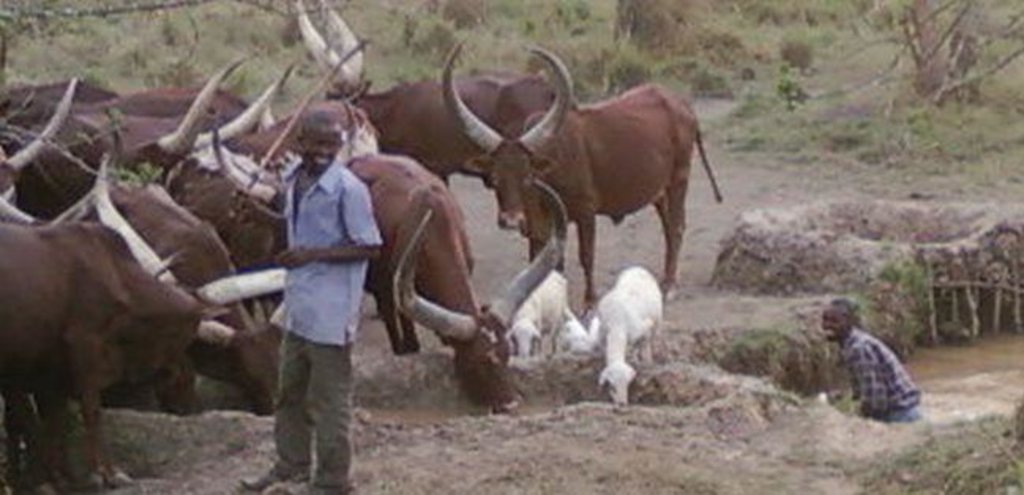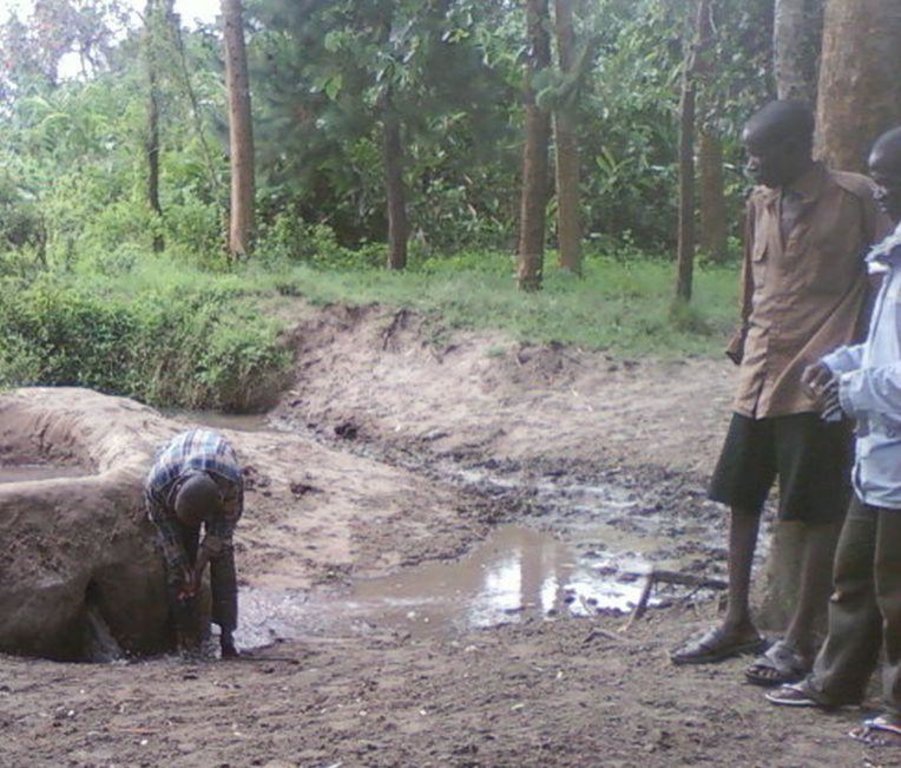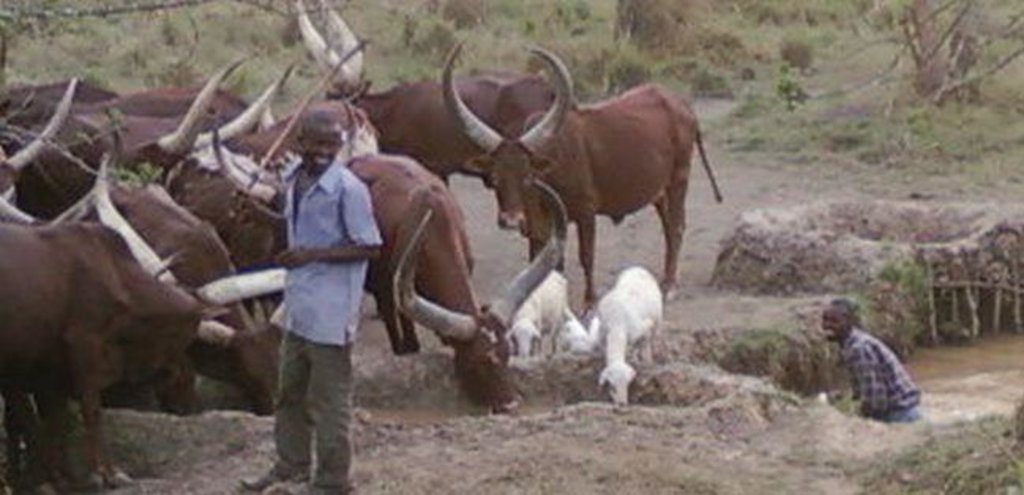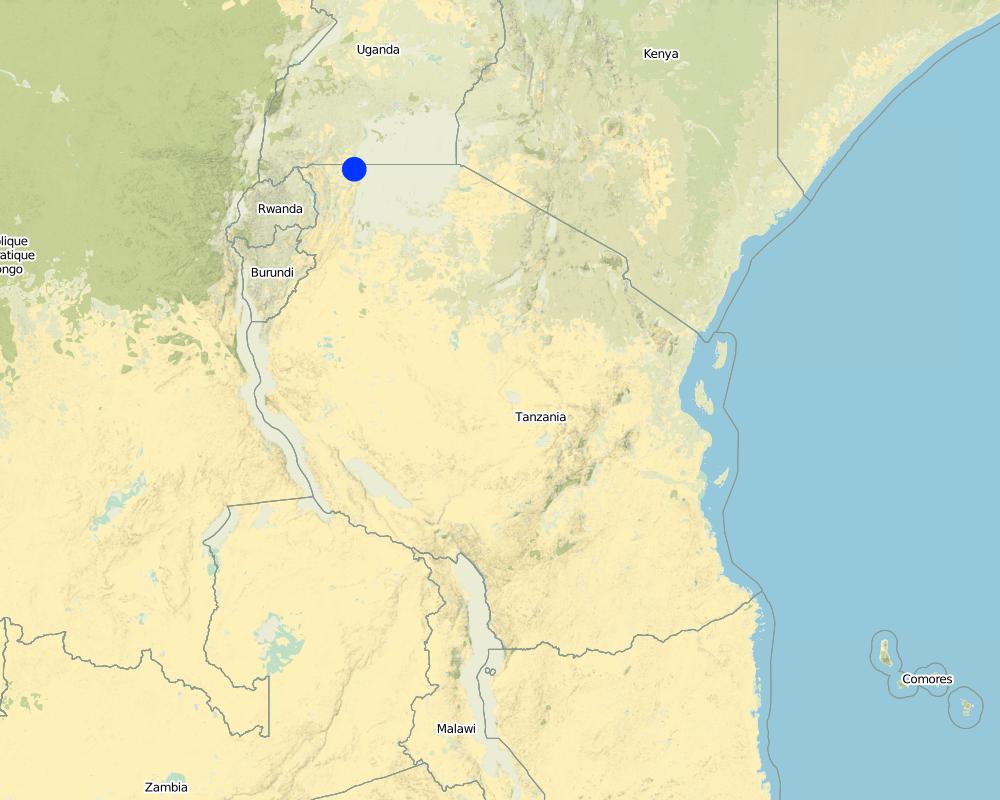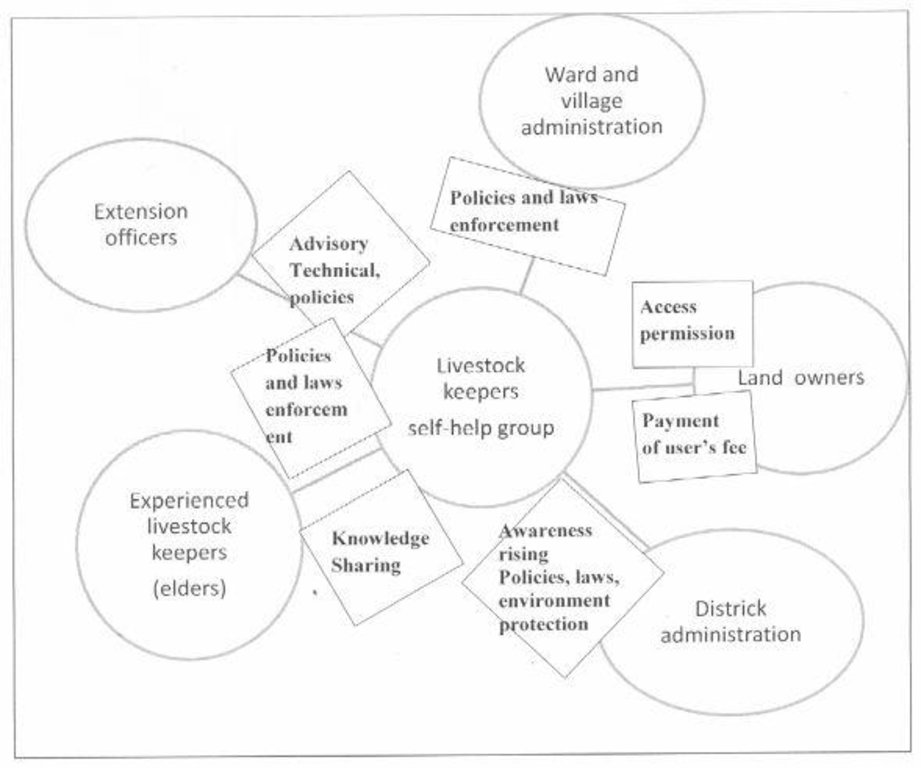Livestock keepers initiative for continued dry season animal drinking water supply [ប្រទេសតង់សានី]
- ការបង្កើត៖
- បច្ចុប្បន្នភាព
- អ្នកចងក្រង៖ ALLAN BUBELWA
- អ្នកកែសម្រួល៖ –
- អ្នកត្រួតពិនិត្យ Fabian Ottiger
Emigilile ya abatungi b’ente oyokueshela ente
approaches_2589 - ប្រទេសតង់សានី
ពិនិត្យមើលគ្រប់ផ្នែក
ពង្រីកមើលទាំងអស់ បង្រួមទាំងអស់1. ព័ត៌មានទូទៅ
1.2 ព័ត៌មានលម្អិតពីបុគ្គលសំខាន់ៗ និងស្ថាប័នដែលចូលរួមក្នុងការវាយតម្លៃ និងចងក្រងឯកសារនៃវិធីសាស្ត្រផ្សព្វផ្សាយ
អ្នកជំនាញឯកទេស SLM:
អ្នកជំនាញឯកទេស SLM:
អ្នកជំនាញឯកទេស SLM:
Subira John
Missenyi district council
ប្រទេសតង់សានី
អ្នកជំនាញឯកទេស SLM:
Kagaruki Annagrace
Missenyi district council
ប្រទេសតង់សានី
អ្នកជំនាញឯកទេស SLM:
Kitundu Elizabeth
+255 0732983531,
missenyicouncil@yahoo.com
Missenyi District Council
Box 38 Kyaka Missenyi Kagera
ប្រទេសតង់សានី
អ្នកជំនាញឯកទេស SLM:
Kaihura Fidelis
National Project Manager
ប្រទេសតង់សានី
ឈ្មោះគម្រោងដែលបានចងក្រងឯកសារ/ វាយតម្លៃលើវិធីសាស្ត្រផ្សព្វផ្សាយ (បើទាក់ទង)
The Transboundary Agro-ecosystem Management Project for the Kagera River Basin (GEF-FAO / Kagera TAMP )ឈ្មោះអង្គភាពមួយ (ច្រើន) ដែលបានចងក្រងឯកសារ/ វាយតម្លៃលើវិធីសាស្ត្រផ្សព្វផ្សាយ (បើទាក់ទង)
Food and Agriculture Organization of the United Nations (FAO) - ប្រទេសអ៊ីតាលីឈ្មោះអង្គភាពមួយ (ច្រើន) ដែលបានចងក្រងឯកសារ/ វាយតម្លៃលើវិធីសាស្ត្រផ្សព្វផ្សាយ (បើទាក់ទង)
Missenyi District Council (Missenyi District Council) - ប្រទេសតង់សានី1.3 លក្ខខណ្ឌទាក់ទងទៅនឹងការប្រើប្រាស់ទិន្នន័យដែលបានចងក្រងតាមរយៈវ៉ូខេត
តើពេលណាដែលទិន្នន័យបានចងក្រង (នៅទីវាល)?
28/08/2012
អ្នកចងក្រង និង(បុគ្គលសំខាន់ៗ)យល់ព្រមទទួលយកនូវលក្ខខណ្ឌនានាទាក់ទងទៅនឹងការប្រើប្រាស់ទិន្នន័យដែលបានចងក្រងតាមរយៈ វ៉ូខេត:
បាទ/ចា៎
1.4 ការយោងមួយ (ច្រើន) ទៅលើ (កម្រង) បញ្ជីសំណួរនៃបច្ចេកទេស SLM
2. ការពណ៌នាអំពីវិធីសាស្ត្រផ្សព្វផ្សាយ SLM
2.1 ពណ៌នាសង្ខេបខ្លីពីវិធីសាស្ត្រផ្សព្វផ្សាយ
Livestock keepers groups and local government collaboration for management of livestock watering points.
2.2 ពណ៌នាលម្អិតពិវិធីសាស្ត្រផ្សព្វផ្សាយ
ពណ៌នាលម្អិតពិវិធីសាស្ត្រផ្សព្វផ្សាយ:
Aims / objectives: The main aim of this approach is to improve management of water resources through strengthening collaboration between land owners and livestock keepers for efficient livestock production/management and increased incomes. This approach ensures livestock watering point accessibility during dry seasons. Objective is to reach a compromise between livestock keepers and land owners on terms of conditions for access and use of watering points. As results livestock keepers and land owner can improve their planning activities and minimize conflict between them.
Methods: A self-help livestock keepers group is normally formed. It establishes regular and efficient cooperation among the livestock keepers and negotiations with land owners on water access issues. They make financial contributions to support the established self-help group. Through these contributions construction and maintenance of the ponds and troughs (the livestock watering system) is assured. Construction and maintenance is also done through voluntary work.
This traditional system was developed by elders and spread through learning by doing from the old to the young generation. In passing over knowledge from the elderly to the youths, experience in livestock and water resources management systems is gained.
The approach is also characterized by reverence to the existing village by-laws reinforced by the village government as well as existing customary laws to prevent degradation and pollution of water sources. Extension officers provide technical backstopping on recommended animal health practices that include deworming, routine spraying and vaccination against diseases.
Stages of implementation: Implementation takes place in three stages
1) Livestock keeper group formation: The group size is determined by the number of livestock. A single trough can accommodate not more than 150 cattle which determine the number of livestock keepers to form a group. The group has its informal organizational system with a nominated leader.
2) Contributions and voluntary works: Each livestock keeper makes a payment of about 20 dollars to the land owner as annual user fee. Maintenance is the responsibility of all livestock keepers.
3) Management: Include use of by-laws and provision of advisory services
Role of stakeholders: Land owner: He has the key role of ensuring that the area is used in a sustainable manner. Group members pay land rent to him for area utilization and management.
Livestock keepers: These are key users of the area, voluntarily participate in construction and maintenance of water troughs, pay land rent, manage and control watering of their animals.
Village and Ward administration and elders: Ensuring that village by-laws and customary laws guiding use of fragile ecosystems are adhered to.
Ward and village extension officers: Provide technical advisory to livestock keepers.
District administration and extension staff: Facilitating and enabling community understanding of policy, acts and laws guiding use of fragile ecosystems so that they can make informed management decision.
Other important information: This approach plays significant role in preventing conflict between domestic water users and livestock keepers especially during the dry season.
2.3 រូបភាពនៃវិធីសាស្ត្រផ្សព្វផ្សាយ
2.5 ប្រទេស/តំបន់/ទីតាំងកន្លែង ដែលវិធីសាស្ត្រផ្សព្វផ្សាយត្រូវបានអនុវត្តន៍
ប្រទេស:
ប្រទេសតង់សានី
តំបន់/រដ្ឋ/ខេត្ត:
TANZANIA
បញ្ជាក់បន្ថែមពីលក្ខណៈនៃទីតាំង:
MISSENYI
Map
×2.7 ប្រភេទនៃវិធីសាស្ត្រផ្សព្វផ្សាយ
- ក្រុមប្រពៃណី/ក្រុមជនជាតិភាគតិច
2.8 គោលបំណង/ទិសដៅសំខាន់នៃវិធីសាស្ត្រផ្សព្វផ្សាយ
The Approach focused mainly on SLM with other activities (Construction, managment and utilization)
Minimizing of land dagradation and better water availability to contribute to livelihood improvement.
The SLM Approach addressed the following problems: 1. There was no livestock keepers organization to comprise over use of water resource during the dry season.
2. Water use conflict between livestock keepers and domestic water users
3. Weak administration of bylaws.
2.9 លក្ខខណ្ឌអនុញ្ញាត ឬរារាំងការអនុវត្តន៍បច្ចេកទេសដែលស្ថិតនៅក្រោមវិធីសាស្រ្តផ្សព្វផ្សាយ
សង្គម/វប្បធម៌/ និងតម្លៃនៃសាសនា
- រារាំង
Traditionally livestock keepers keep large herds for prestige.
Treatment through the SLM Approach: Livestock keeper with large herds are advised to reduce number of animals by selling extra animals and use funds for intensifying management and maximizing productivity.
ភាពអាចរកបាននៃធនធានហិរញ្ញវត្ថុ និងសេវាកម្ម
- រារាំង
Livestock keepers are not aware of the services provided by financial institutions and are ignorant of the basic bookkeeping skills.
Treatment through the SLM Approach: Sensitized livestock keepers on utilization of financial institutions and provide training in the basic bookkeeping skills.
បរិបទនៃស្ថាប័ន
- រារាំង
Livestock keepers informally organized but not legally recognized; the groups are not registered and have no written constitution.
Treatment through the SLM Approach: Livestock keeper advised to strengthen their groups/organization through registration by relevant authorities and establish a written group constitution.
ក្របខណ្ឌច្បាប់ (សិទ្ធិកាន់កាប់ដីធ្លី កម្មសិទ្ធីប្រើប្រាស់ដីនិងទឹក)
- រារាំង
Ignorance of livestock keepers on the Act, Laws and Rules governing the use of fragile ecosystems.
Treatment through the SLM Approach: Extension workers enabling and facilitating community understanding of policy and acts guiding use of fragile ecosystems.
ចំណេះដឹងស្តីពី SLM និងការទទួលបានការគាំទ្រផ្នែកបច្ចេកទេស
- រារាំង
Low knowledge on recommended livestock rearing practises and water borne diseases.
Treatment through the SLM Approach: Training livestock keepers on recommended livestock rearing practices, prevention and controll of water borne diseases as well as water hygine and sanitation.
ទំហំការងារ ភាពអាចរកបាននៃកម្លាំងពលកម្ម
- រារាំង
High work load needed in filling of the water troughs
Treatment through the SLM Approach: Livestock keepers advised to use water pumping machines (simple and manually operated machines).
3. ការចូលរួម និងតួនាទីរបស់ភាគីពាក់ព័ន្ធ
3.1 អ្នកពាក់ព័ន្ធដែលបានចូលរួមក្នុងវិធីសាស្ត្រផ្សព្វផ្សាយ និងតួនាទីរបស់ពួកគេ
- អ្នកប្រើប្រាស់ដីក្នុងតំបន់/សហគមន៍
Key implementer and user of the SLM approach, the land owner and the livestock keepers
Traditionally grazing stocks (cattle, sheep and goats) are owned and reared by men and therefore the approach mainly involves men. The roles area largely men specific.The approach also targeted low income livestock owners (casual cattle herds man).
- អ្នកឯកទេសគ្រប់គ្រងដីប្រកបដោយចីរភាព/ទីប្រឹក្សាបច្ចេកទេសកសិកម្ម
District, ward and village extension officers
- រដ្ឋាភិបាលថ្នាក់មូលដ្ឋាន
Provision of technical advisory services, policy and act interpretation and reinforcement of village bylaws.
- រដ្ឋាភិបាលថ្នាក់ជាតិ (អ្នករៀបចំផែនការ អ្នកសម្រេចចិត្ត)
Village and Ward elected and employed representatives.
3.2 ការចូលរួមរបស់អ្នកប្រើប្រាស់ដីក្នុងតំបន់/ សហគមន៍ក្នុងតំបន់ក្នុងដំណាក់កាលផ្សេងគ្នានៃវិធីសាស្រ្តផ្សព្វផ្សាយ
| ការចូលរួមរបស់អ្នកប្រើប្រាស់ដីក្នុងតំបន់/សហគមន៍ក្នុងតំបន់ | សូមបញ្ជាក់នរណាត្រូវបានចូលរួម ព្រមទាំងពណ៌នាសកម្មភាពទាំងនោះ | |
|---|---|---|
| ការចាប់ផ្តើម/ការលើកទឹកចិត្ត | គំនិតផ្តួចផ្តើមដោយខ្ឡួនឯង | Livestock keepers /elders: Inheritance and transference of the approach to youth. |
| ការរៀបចំផែនការ | គំនិតផ្តួចផ្តើមដោយខ្ឡួនឯង | Livestock keepers /elders: Informal planning and improvement through cycles of action and reflection. |
| ការអនុវត្តន៍ | គំនិតផ្តួចផ្តើមដោយខ្ឡួនឯង | Livestock keepers individuals and groups, village leaders and agricultural advisers: use of the approach, law enforcement and technical advisory services and interpretation of act, law and guidelines protecting fragile ecosystems. |
| ការត្រួតពិនិត្យ និងវាយតម្លៃ | គំនិតផ្តួចផ្តើមដោយខ្ឡួនឯង | Livestock keepers individuals and groups, village leaders and agricultural advisers and SLM specialists: manage effective use of the technology, ensure adherence of Acts, Rules and Regulation and SLM documentation for dissemination and sharing. |
| Research | អន្តរកម្ម | Livestock keepers individuals and groups and agricultural advisers and SLM specialists: identification and documentation of researchable issues. |
3.3 គំនូសបំព្រួញ (ប្រសិនបើមាន)
ការពណ៌នា:
Livestock keepers initiative for continued dry season animal drinking water supply.
អ្នកនិពន្ធ:
Allan Bubelwa (Box 38 Kyaka, Missenyi, Kagera, United Tanzania)
3.4 ការសម្រេចចិត្តលើការជ្រើសរើសបច្ចេកទេស SLM
សូមបញ្ជាក់តើអ្នកណាជាអ្នកបានសម្រេចចិត្តក្នុងការជ្រើសរើសបច្ចេកទេសដើម្បីយកមកអនុវត្តន៍:
- អ្នកប្រើប្រាស់ដីដោយខ្លួនឯងផ្ទាល់ (គំនិតផ្តួចផ្តើមដោយខ្លួនឯង)
ចូរពន្យល់:
A decision to use the technology relies on livestock keepers self-mobilization, own choice induced through inheritance and learning by doing.
Decisions on the method of implementing the SLM Technology were made by by land users* alone (self-initiative / bottom-up). Decision to use the method is partly through spontaneous adoption from elders and improvement through cycles of action and reflection.
4. ជំនួយបច្ចេកទេស ការកសាងសមត្ថភាព និងការគ្រប់គ្រងចំណេះដឹង
4.1 ការកសាងសមត្ថភាព/ បណ្តុះបណ្តាល
តើវគ្គបណ្តុះបណ្តាលបានផ្តល់ឱ្យអ្នកប្រើប្រាស់ដី/អ្នកពាក់ព័ន្ធផ្សេងៗទៀតដែរឬទេ?
បាទ/ចា៎
សូមបញ្ជាក់តើអ្នកណាត្រូវបានបណ្តុះបណ្តាល:
- អ្នកប្រើប្រាស់ដី
- បុគ្គលិកចុះទីវាល/អ្នកផ្តល់ប្រឹក្សាយោបល់
- village and ward leaders
ប្រសិនទាក់ទង សូមបញ្ជាក់ ភេទ អាយុ ស្ថានភាពគ្រួសារ ជនជាតិដើមភាគតិច។ល។:
both men and women and all ages (youth and elders).
ទម្រង់នៃការបណ្តុះបណ្តាល:
- អនុវត្តន៍ជាមួយការងារ
- ការប្រជុំជាសាធារណៈ
ទម្រង់នៃការបណ្តុះបណ្តាល:
- seminar and workshops.
ប្រធានបទបណ្តុះបណ្តាល:
Act and Laws guiding the use of fragile ecosystems, prevention of water borne diseases, recommended livestock keeping methods and water management.
4.2 សេវាផ្តល់ប្រឹក្សាយោបល់
តើអ្នកប្រើប្រាស់ដីបានទទួលនូវសេវាផ្តល់ប្រឹក្សាដែរ ឬទេ?
បាទ/ចា៎
សូមបញ្ជាក់ប្រសិនបើសេវាកម្មប្រឹក្សាយោបល់ត្រូវបានផ្តល់ឱ្យ:
- នៅលើដីរបស់អ្នកប្រើប្រាស់ដី
ពណ៌នា/ពន្យល់:
Name of method used for advisory service: Farmer field school ; Key elements: learning by doing on the job and in the field (Number of knowledge sharing activities: on the job training, field practice), adult learning – livestock self-help groups , livestock management. , indegenous and technical knowledge balanced and combined in a complementary manner.; Technical advisory services largely involved building on and improving the successful experience resulted from the use of indigenous knowledge.
Advisory service is quite adequate to ensure the continuation of land conservation activities; The increase number of extension workers from 1 to 2 and introduction of TAMP project (trans boundary agro-ecosystem management project) in the village will speed up implementation of conservation activities in the village.
4.3 ការពង្រឹងសមត្ថភាពស្ថាប័ន (ការអភិរឌ្ឍន៍អង្គភាព)
តើស្ថាប័នទាំងអស់ត្រូវបានបង្កើតឡើង ឬពង្រឹងសមត្ថភាពតាមរយៈវិធីសាស្ត្រផ្សព្វផ្សាយដែរ ឬទេ?
- ទេ
4.4 ការត្រួតពិនិត្យ និងវាយតម្លៃ
តើការត្រួតពិនិត្យ និងវាយតម្លៃគឺជាផ្នែកមួយនៃវិធីសាស្ត្រដែរឬទេ?
បាទ/ចា៎
មតិយោបល់:
bio-physical aspects were ad hoc monitored by government, land users through observations; indicators: extent of area eroded
bio-physical aspects were ad hoc monitored by government, land users through measurements; indicators: Ponds/troughs and maintenance requirements
technical aspects were ad hoc monitored by land users through observations; indicators: number of livestock keeper trained
technical aspects were ad hoc monitored by land users through measurements; indicators: number of conflicts between land owners and livestock keepers
socio-cultural aspects were ad hoc monitored by land users through observations; indicators: number of water conflict emerged and number resolved
socio-cultural aspects were ad hoc monitored by government, land users through measurements; indicators: livestock production and productivity
economic / production aspects were regular monitored by government through observations; indicators: increase in milk and meat productivity
economic / production aspects were regular monitored by government, land users through measurements; indicators: livestock keepers using the technology
no. of land users involved aspects were regular monitored by government, land users through observations; indicators: number of livestock keepers using the technology
no. of land users involved aspects were regular monitored by government, land users through measurements; indicators: adherence to water protective bylaws
management of Approach aspects were regular monitored by government through observations; indicators: % number of village bylaws used and adhered to
management of Approach aspects were regular monitored by government through measurements; indicators: None
There were few changes in the Approach as a result of monitoring and evaluation: Implementation of group roles and adherence to by-laws e.g. protection of natural vegetation.
There were few changes in the Technology as a result of monitoring and evaluation: decrease in destruction of natural vegetation and reduction of eutrophication at the water source.
4.5 ការស្រាវជ្រាវ
តើការស្រាវជ្រាវ គឺជាផ្នែកមួយនៃវិធីសាស្រ្តដែរឬទេ?
បាទ/ចា៎
- adaptive SLM trials
សូមផ្តល់ព័ត៌មានបន្ថែមទៀតឱ្យបានលម្អិត និងចង្អុលបង្ហាញនរណាដែលបានធ្វើការស្រាវជ្រាវ:
Adaptive trials through SLM demos by TAMP, ARI MARUKU and community. Farmers select the best bets technologies to apply on their own fields.
Research was carried out on-farm
5. ថវិកា និងសម្ភារៈឧបត្ថម្ភពីខាងក្រៅ
5.1 ថវិកាប្រចាំឆ្នាំសម្រាប់ផ្សព្វផ្សាយ SLM
ប្រសិនបើចំនួនពិតប្រាកដនៃថវិកាប្រចាំឆ្នាំមិនត្រូវបានដឹងច្បាស់ សូមប្រាប់ពីចន្លោះនៃថវិកានោះ:
- < 2,000
មតិយោបល់ (ឧ. ប្រភពសំខាន់នៃមូលនិធិ/ម្ចាស់ជំនួយចំបង):
Approach costs were met by the following donors: local government (district, county, municipality, village etc) (animal related extesion services, policy and law enforcement.): 20.0%; local community / land user(s) (voluntary contribution by livestock keeper groups and land owner ): 80.0%
5.2 ការគាំទ្រផ្នែកហិរញ្ញវត្ថុ / សម្ភារៈដែលបានផ្តល់ទៅឱ្យអ្នកប្រើប្រាស់ដី
តើអ្នកប្រើប្រាស់ដីបានទទួលការគាំទ្រផ្នែកហិរញ្ញវត្ថ/សម្ភារៈសម្រាប់ការអនុវត្តន៍បច្ចេកទេសដែរឬទេ:
ទេ
5.3 សូមបញ្ជាក់ពីធាតុចូលត្រូវបានផ្តល់បដិភាគ (រួមទាំងកម្លាំងពលកម្ម)
ប្រសិនបើកម្លាំងពលកម្មធ្វើដោយអ្នកប្រើប្រាស់ដី តើវាជាធាតុចូលដ៏សំខាន់មួយដែរ ឬទេ:
- ដោយស្ម័គ្រចិត្ត
មតិយោបល់:
labour is needed in taking the animals for watering as well as during actual watering of the animals.
5.4 ឥណទាន
តើឥណទានដែលបានផ្តល់នៅក្រោមវិធីសាស្ត្រផ្សព្វផ្សាយសម្រាប់សកម្មភាព SLM នេះយ៉ាងដូចម្តេច?
ទេ
6. ការវិភាគរកផលប៉ះពាល់ និងសេចក្តីសន្និដ្ឋាន
6.1 ផលប៉ះពាល់នៃវិធីសាស្ត្រផ្សព្វផ្សាយ
តើវិធីសាស្ត្រផ្សព្វផ្សាយជួយអ្នកប្រើប្រាស់ដីដើម្បីអនុវត្តន៍ និងថែទាំបច្ចេកទេស SLM?
- ទេ
- បាទ/ច៎ា បន្តិចបន្តួច
- បាទ/ច៎ា ជាមធ្យម
- បាទ/ច៎ា បានខ្លាំង
This approach plays significant role in reducing conflict between domestic water users, increased availability of water and conservation of water resources.
តើវិធីសាស្ត្រផ្សព្វផ្សាយនេះផ្តល់សិទ្ធិអំណាចដល់សង្គមនិងសេដ្ឋកិច្ចដែលក្រុមមិនទទួលបានផលប្រយោជន៍?
- ទេ
- បាទ/ច៎ា បន្តិចបន្តួច
- បាទ/ច៎ា ជាមធ្យម
- បាទ/ច៎ា បានខ្លាំង
The approach enables low income-cattle herd man to earn income.
Did other land users / projects adopt the Approach?
- ទេ
- បាទ/ច៎ា បន្តិចបន្តួច
- បាទ/ច៎ា ជាមធ្យម
- បាទ/ច៎ា បានខ្លាំង
other livestock group adopted the approach (in dry season).
Did the Approach lead to improved livelihoods / human well-being?
- ទេ
- បាទ/ច៎ា បន្តិចបន្តួច
- បាទ/ច៎ា ជាមធ្យម
- បាទ/ច៎ា បានខ្លាំង
Livestock keepers that joined self-help groups improved livestock productivity and increased income
Did the Approach help to alleviate poverty?
- ទេ
- បាទ/ច៎ា បន្តិចបន្តួច
- បាទ/ច៎ា ជាមធ្យម
- បាទ/ច៎ា បានខ្លាំង
year round availability of water for animals, increased animal production and productivity and income to livestock keepers and improve rural socio-economic conditions.
6.2 ការលើកទឹកចិត្តចម្បងៗរបស់អ្នកប្រើប្រាស់ដីសម្រាប់ការអនុវត្តបច្ចេកទេស SLM
- បង្កើនផលិតកម្ម
improved animals heath and increased production
- ច្បាប់ និងបទបញ្ជា (ផាកពិន័យ)/ការប្រតិបត្តិ
rules preventing livestock keepers from watering their animals in domestic water sources
- ពង្រឹងស្មារតីផ្នែកបរិស្ថាន
developed through various SLM trainings provided by extension officers.
6.3 សកម្មភាពផ្សព្វផ្សាយដែលប្រកបដោយចីរភាព
តើអ្នកប្រើប្រាស់ដីអាចធ្វើឱ្យមានចីរភាពនូវអ្វីដែលត្រូវបានអនុវត្តន៍តាមរយៈវិធីសាស្ត្រផ្សព្វផ្សាយដែរឬទេ(ដោយពុំមានការគាំទ្រពីអ្នកខាងក្រៅ)?
- មិនប្រាកដ
ប្រសិន ទេ ឬមិនប្រាកដសូមបញ្ជាក់ និងពន្យល់:
in the future a support is needed in terms of group management and organizational development, marketing and business planning skills and livestock keepers also need further exposure to SLM concept.
6.4 ភាពខ្លាំង/ គុណសម្បត្តិនៃវិធីសាស្ត្រផ្សព្វផ្សាយ
| ភាពខ្លាំង/ គុណសម្បត្តិ/ ឱកាស ទស្សនៈរបស់អ្នកប្រើប្រាស់ដី |
|---|
| Is a mechanism for assurance of water availability for animal watering in the dry season. (How to sustain/ enhance this strength: continue with good collaboration with the land owner and livestock keeper solidarity.) |
| ភាពខ្លាំង/ គុណសម្បត្តិ/ ឱកាស ទស្សនៈរបស់បុគ្គលសំខាន់ៗ |
|---|
| The training of extension officers, elders etc covered many aspects of sustainable livestock production and natural water resources protection (How to sustain/ enhance this strength: Activities presented during the training should be put into practice and spread among other livestock keepers ) |
| Involvement of the district administration, wards, elders in the approaches implementation (How to sustain/ enhance this strength: insist on active involvement ) |
| Strong commitment of livestock keepers to improve livestock production and their livelihood (How to sustain/ enhance this strength: Awareness raising ) |
| Reduced conflict between water for domestic use and for watering animals (How to sustain/ enhance this strength: strengthen use of the approach and bylaws guiding it ) |
| Reduced cost and largely relies on self mobilization and voluntarism of the livestock keepers. (How to sustain/ enhance this strength: Group management and organizational development to strengthen cohesiveness.) |
| Is dynamic, flexible and accommodate outside advisory and technical support and therefore opens opportunities for future improvement. (How to sustain/ enhance this strength: Needs assessment and provision of appropriate advisory and technical support. ) |
6.5 ភាពខ្សោយ/ គុណវិបត្តិនៃវិធីសាស្ត្រ និងរកដំណោះស្រាយ
| ភាពខ្សោយ/ គុណវិបត្តិ/ ហានិភ័យ ទស្សនៈរបស់អ្នកប្រើប្រាស់ដី | តើបច្ចេកទេសទាំងនោះបានដោះស្រាយបញ្ហាដូចម្តេច? |
|---|---|
| low know how | broadern know how |
| ភាពខ្សោយ/ គុណវិបត្តិ/ ហានិភ័យក្នុងទស្សនៈរបស់បុគ្គលសំខាន់ៗ | តើបច្ចេកទេសទាំងនោះបានដោះស្រាយបញ្ហាដូចម្តេច? |
|---|---|
| The approach is largely informal in terms of livestock keepers organization. There is no written constitution and the groups are not registration. | improvement in terms of formulation of group constitution, opening of bank account and group registration. |
| Narrow focus largely relies solely on indigenous knowledge base . | broaden horizon of understanding by combining with technical knowledge base. |
| Lack of promotion materials to involve other livestock keepers | increase number of promotion materials |
| Rural poverty not reduced significantly | more activities that can lead to reduction of rural poverty required |
7. ឯកសារយោង និងវេបសាយ
7.1 វិធីសាស្ត្រ/ ប្រភពនៃព័ត៌មាន
- តាមការចុះទីវាល ការស្រាវជ្រាវនៅទីវាល
- ការសម្ភាសន៍ជាមួយអ្នកប្រើប្រាស់ដី
7.2 ឯកសារយោងដែលបានចេញផ្សាយ
ចំណងជើង អ្នកនិពន្ធ ឆ្នាំ ISBN:
Kagera TAMP project (pdfFinal Report 2013)
មានប្រភពមកពីណា? ថ្លៃដើមប៉ុន្មាន?
http://www.fao.org/fileadmin/user_upload/oed/docs/GCPRAF424GFF_2013_ER.pdf
ការតភ្ជាប់ និងម៉ូឌុល
ពង្រីកមើលទាំងអស់ បង្រួមទាំងអស់ការតភ្ជាប់
គ្មានការតភ្ជាប់
ម៉ូឌុល
គ្មានម៉ូឌុល



